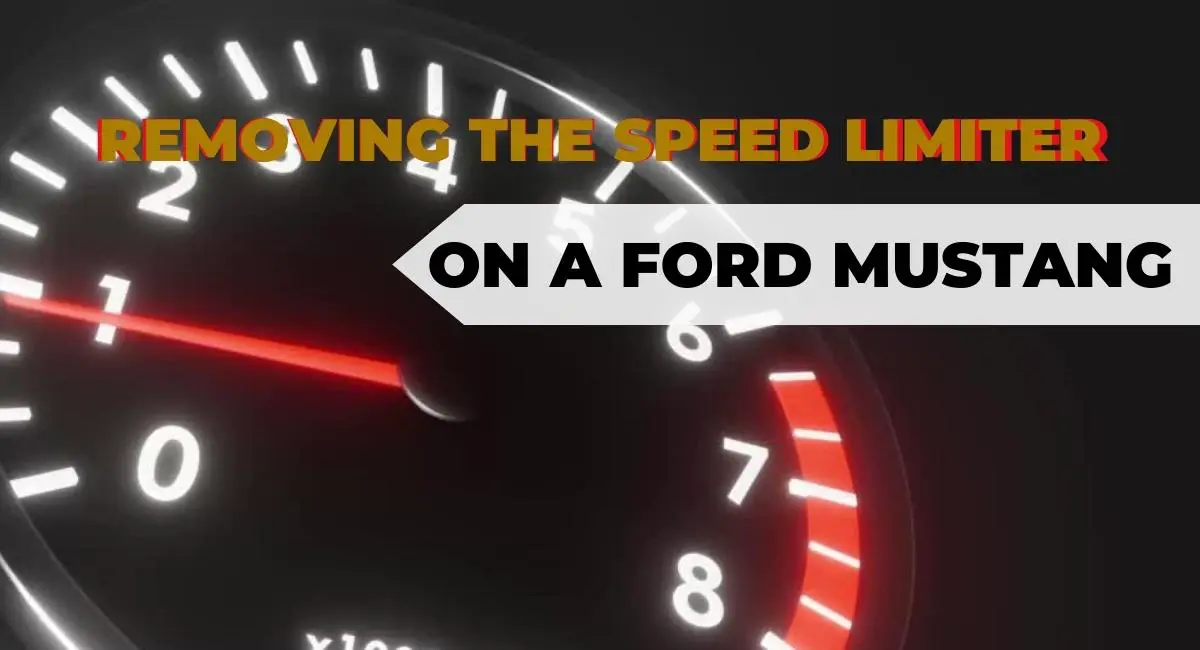The Ford Mustang is an iconic symbol of raw power, speed, and American muscle. For speed enthusiasts, this car isn’t just a mode of transportation but a statement, a thrill, a pure driving experience. Yet, even these high-performance machines come with limitations, specifically in the form of a speed limiter.
A speed limiter, also known as a governor, is a device installed in vehicles to regulate maximum speed. Car manufacturers, including Ford, install these limiters for safety, adherence to local and international road regulations, and ensuring vehicle longevity. Mustangs, with their powerful engines and exceptional speed capabilities, are not exempt from these speed caps.
This guide will venture into the intricate process of removing the speed limiter on a Mustang. It will offer a deeper understanding of the speed limiter’s purpose, the tools and knowledge required for its removal, and, importantly, the process’s legal, safety, and warranty implications.
Understanding the Ford Mustang’s Speed Limiter
Ford Mustangs, known for their power and performance, come fitted with speed limiters to enhance safety and comply with various country-specific regulations. The Mustang’s speed limiter prevents the car from reaching speeds that could compromise the car’s stability and the driver’s control. While this might disappoint some speed enthusiasts, it’s crucial to remember that these limiters exist for safety reasons.
Moreover, altering the speed limiter can have legal implications depending on your location. Many countries have strict laws against tampering with installed safety features. So, before you venture down this road, understand the consequences. Most drivers who eliminate the speed limiter on their Mustang do so to register the vehicle for officially sanctioned track races.

Theoretical Process of Removing the Speed Limiter on a Mustang
Removing the speed limiter on a Ford Mustang involves electronic tuning tools and software. Such tools interact with the car’s Engine Control Unit (ECU), the computer controlling the engine’s functionalities, including the speed limiter. But what’s ECU chipping?
What is ECU chipping?
ECU chipping, also called “ECU tuning” or “remapping,” refers to the procedure of altering the software program within a vehicle’s Engine Control Unit (ECU). The ECU is essentially the vehicle’s brain—it’s a computer system that controls various aspects of the engine’s performance, including fuel/air mixture, ignition timing, idle speed, and even the vehicle’s speed limit.
Chipping the ECU involves replacing or modifying the default software with new software to enhance the car’s performance. It might include adjustments that improve fuel efficiency, power output, or even the car’s responsiveness.
However, ECU chipping should always be done by a professional or someone with in-depth knowledge of a vehicle’s electronic systems, as incorrect modifications can lead to various issues, including engine damage or even complete engine failure. Furthermore, it’s important to remember that altering the ECU may void the vehicle’s warranty and could have legal and insurance implications.
You should remember to take caution when modifying your Ford Mustang. You should have the necessary technical skills or consult with a professional to avoid damaging your car’s internal systems. Also, it’s worth noting that such modifications can void your car’s warranty, so weigh the pros and cons before proceeding.
Step-by-Step Guide on How to Remove the Speed Limiter on a Mustang
It’s important to remember that removing the speed limiter on a Mustang involves interaction with the car’s Engine Control Unit (ECU) and should be handled with care and technical know-how. If you need more clarification or are not comfortable with the procedure, it’s best to consult a professional.
The process of removing the speed limiter on a Mustang can vary depending on the model. For older Mustangs, it typically involves removing a few screws to gain access to the speed limiter. On the other hand, newer Mustangs often allow access through a back panel.
Before you start, also remember to review the previous cautions regarding legality, safety, insurance, and warranty implications. The following steps aim to give a general overview:
- Initiating the speed limiter from your Mustang differs in different models of Mustang. You can start by raising the car using a jack. It creates ample room to work and alleviates pressure on the wheels for enhanced safety. With your Mustang securely jacked up,
- Identify the ECU – The ECU is usually located in the passenger footwell, behind the glove box, or under the hood. Its location varies depending on your Mustang’s model year.
- Purchase a Tuning Device – You’ll need an ECU tuning device compatible with your Mustang. These devices have software that allows you to adjust various engine parameters, including removing the Ford Mustang speed limiter. These programmers are typically not readily available in physical stores, so purchasing one online or through a specialty catalog is advisable.
- Connect the Tuning Device – Connect the device to the OBD-II (On-Board Diagnostics) port in your Mustang, usually found under the dashboard. Ensure all electronic devices in the vehicle, including the radio and all lights, are switched off. For instance, detach the negative battery cable to prevent electrical shocks during your work on the system.
- Launch the Tuning Software – Use the provided software to access your Mustang’s ECU settings. But carefully go through the instructions provided by the programmer. While many programmers automatically load performance-enhancing programs, they typically don’t remove the speed limiter. Hence, it’s crucial to understand how to personalize the program so you can manually adjust the speed limiter settings.,
- Adjust the Speed Limiter Setting – Find the speed limiter setting and adjust it as desired. If not done correctly, altering this could potentially harm your vehicle.
- Save and Exit – Save your changes and disconnect the device once you’ve adjusted.
Adjusting Ford Mustang Speed Limit on Different Models
Removing the Mustang speed limit is an easy task with a professional. It involves enlisting the services of a reputable tuner who can assist you with removing the speed limiter. By obtaining a tuner (typically costing around $300-$400), you can have your vehicle tuned, and the tuner will be able to eliminate the speed limiter for you. If desired, the tuner can also address the removal of traction control, rear oxygen sensors, and other specific components.
However, understanding your Mustang’s specific year and model is crucial before attempting to alter its speed limit. If your Mustang is a base GT or V6 from 1999–2004, its speed is limited to 130mph because it comes equipped with H-rated tires from the factory. To safely exceed 130mph, you would need Z, V, W, or Y-rated tires, provided that other systems (like the drivetrain, body, and suspension) are in good condition, especially considering that your car could be over 14 years old.
For Mustang models from 2005–2010, the V6 versions came with a driveshaft with a design that cannot handle speeds over 130mph, and they might also have an installation of H-rated tires. Upgrading to a high-speed compatible driveshaft can cost up to $800 from aftermarket vendors.
After-Effects and Considerations After Removing the Mustang’s Speed Limiter
Following the removal of the speed limiter on your Mustang, you might experience several after-effects and considerations:
- Increased Top Speed: The most immediate effect will be an increase in the Mustang speed limit. It may seem enticing to some drivers but remember that higher speeds also carry greater risks.
- Vehicle Stability: While Mustang’s design handles high speeds, the speed limiter is also a safeguard to prevent instability at extreme speeds. Without this, the vehicle may behave differently at high speeds, which could lead to dangerous driving conditions.
- Potential Mechanical Issues: Driving at higher speeds may strain your vehicle’s engine, transmission, and other components. It could lead to more frequent maintenance needs and a shorter lifespan for the car.
- Fuel Efficiency: Operating your Mustang at higher speeds may decrease fuel efficiency. It could increase your fuel costs over time.
- Legal Consequences: As previously mentioned, there could be legal implications if your vehicle has had its speed limiter removed, especially in the event of a speed-related accident or violation.
- Insurance Implications: Your vehicle insurance provider may increase your premiums if they learn the speed limiter has been removed due to the increased risk of high-speed accidents. In some cases, they could even refuse to cover your vehicle.
- Voiding the Warranty: Many car manufacturers consider such modifications a violation of the vehicle’s warranty. If something goes wrong with your Mustang after removing the speed limiter, you may have to pay out of pocket for repairs.
Conclusion
Removing the speed limiter from a Ford Mustang is a task that requires a clear understanding of your vehicle’s mechanics, potential legal issues, and the implications for vehicle performance and safety. Maintaining the integrity of manufacturer-installed safety features, including the speed limiter, is always recommended to ensure optimal performance and safety. Always consider the potential risks and effects of your warranty and insurance before undertaking such modifications. Stay informed, stay safe, and enjoy the drive in your Ford Mustang.
